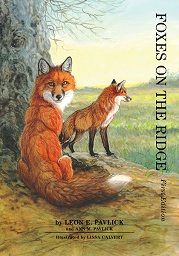| ________________
CM . . .
. Volume XX Number 25. . . .February 28, 2014
excerpt:
The “my ridge” referenced in the excerpt above is the same Manitoba ridge that was the focal point of the Pavlicks’ earlier book, Red Pines on the Ridge. Whereas that book focused principally on the ridge’s flora, this title emphasizes its fauna as it follows a newly born fox through his first year of life. The pup gets an early answer to the excerpt’s closing question as the discovery of the foxes’ den by some humans causes the protective vixen to relocate her five pups to a more secluded den on the ridge. Though “Red foxes and open lands fit well together”, that fit is less perfect when it is men and their machinery that have created these open lands. As spring gives way to summer and the fox matures, he is taught how to hunt, and he discovers that “Mother and father provide us less and less food – and we each provide more and more for ourselves.” When the frosts of autumn arrive, “I was on my own, fending for myself”, and since “[my] home territory could not provide all of us with enough food, so I had to roam and seek.” After much wandering, the fox could say, “Finally I came to an area where there were no scent posts, no other foxes.” There, the fox spends its winter until he is joined by a female. They mate, and, with the onset of spring, she births six pups, and the cycle of life begins anew. The illustrations of wildlife artist Lissa Calvert, which appear on virtually every page, are rendered in both black and white and full-colour. Calvert’s art more than reproduces the Pavlicks’ words; it extends them. For example, when the text reads:
Calvert’s illustration reveals the den at the point it was discovered by two human males who are accompanied by a pair of dogs, one of which is sniffing at the den’s entrance. Ominously, one of the humans is carrying a long gun, either a rifle or a shotgun. Another example of an illustration conveying more information than is found in the text also involves humans. The maturing fox observes, “One evening one of my brothers killed a white chicken in a farmer’s yard. Shortly after that I learned about man’s traps, man’s snares and man’s guns.” Calvert’s illustration accompanying that text shows the young fox, his tail drooping, looking at the carcass of one of his siblings. Without being didactic, the Pavlicks' text presents a great deal of factual information not only about foxes, but also about the foxes’ prey and the predators they must avoid. The writing style is quite poetic and visual, as can be seen in the following passage.
A most worthy addition to libraries’ nature shelves. Highly Recommended. Dave Jenkinson, CM’s editor, lives in Winnipeg, MB, and has been fortunate enough to observe foxes in their natural environment.
To comment
on this title or this review, send mail to cm@umanitoba.ca.
Copyright © the Manitoba Library Association. Reproduction for personal
use is permitted only if this copyright notice is maintained. Any
other reproduction is prohibited without permission.
NEXT REVIEW |
TABLE OF CONTENTS FOR THIS ISSUE
- February 28, 2014.
AUTHORS |
TITLES |
MEDIA REVIEWS |
PROFILES |
BACK ISSUES |
SEARCH |
CMARCHIVE |
HOME |
